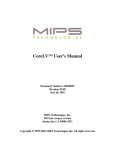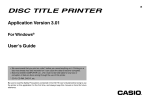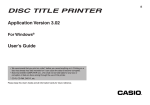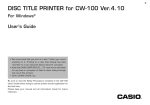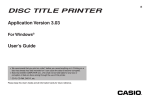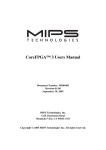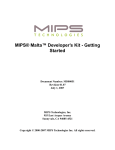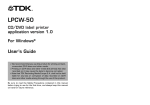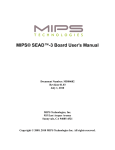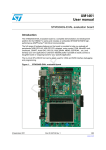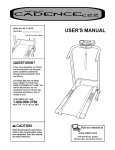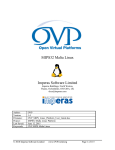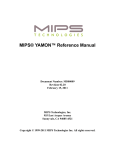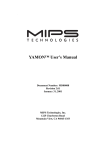Download CoreLV™ User`s Manual
Transcript
l CoreLV™ User’s Manual Document Number: MD00007 Revision 02.06 January 23, 2001 MIPS Technologies, Inc. 1225 Charleston Road Mountain View, CA 94043-1353 Copyright © 1999-2000 MIPS Technologies, Inc. All rights reserved. Unpublished rights reserved under the Copyright Laws of the United States of America. This document contains information that is proprietary to MIPS Technologies, Inc. (“MIPS Technologies”). Any copying, modifyingor use of this information (in whole or in part) which is not expressly permitted in writing by MIPS Technologies or a contractually-authorized third party is strictly prohibited. At a minimum, this information is protected under unfair competition laws and the expression of the information contained herein is protected under federal copyright laws. Violations thereof may result in criminal penalties and fines. MIPS Technologies or any contractually-authorized third party reserves the right to change the information contained in this document to improve function, design or otherwise. MIPS Technologies does not assume any liability arising out of the application or use of this information. Any license under patent rights or any other intellectual property rights owned by MIPS Technologies or third parties shall be conveyed by MIPS Technologies or any contractually-authorized third party in a separate license agreement between the parties. The information contained in this document constitutes one or more of the following: commercial computer software, commercial computer software documentation or other commercial items. If the user of this information, or any related documentation of any kind, including related technical data or manuals, is an agency, department, or other entity of the United States government (“Government”), the use, duplication, reproduction, release, modification, disclosure, or transfer of this information, or any related documentation of any kind, is restricted in accordance with Federal Acquisition Regulation 12.212 for civilian agencies and Defense Federal Acquisition Regulation Supplement 227.7202 for military agencies. The use of this information by the Government is further restricted in accordance with the terms of the license agreement(s) and/or applicable contract terms and conditions covering this information from MIPS Technologies or any contractually-authorized third party. MIPS, R3000, R4000, R5000, R8000 and R10000 are among the registered trademarks of MIPS Technologies, Inc., and R4300, R20K, MIPS16, MIPS32, MIPS64, MIPS-3D, MIPS I, MIPS II, MIPS III, MIPS IV, MIPS V, MDMX, SmartMIPS, 4K, 4Kc, 4Km, 4Kp, 5K, 5Kc, 20K, 20Kc, EC, MGB, SOC-it, SEAD, YAMON, ATLAS, JALGO, CoreLV and MIPS-based are among the trademarks of MIPS Technologies, Inc. All other trademarks referred to herein are the property of their respective owners. CoreLV™ User’s Manual, Revision 02.06 Table of Contents 1 Introduction ................................................................................................................................................................4 2 Installation ..................................................................................................................................................................5 3 Description .................................................................................................................................................................6 3.1 CPU ..................................................................................................................................................................6 3.1.1 CPU Power Supply ................................................................................................................................6 3.2 System Controller GT64120 ............................................................................................................................6 3.2.1 Programming Notes ...............................................................................................................................7 3.3 SDRAM ...........................................................................................................................................................8 3.4 CBUS ...............................................................................................................................................................8 3.5 Interrupts ..........................................................................................................................................................9 3.6 JTAG Chain .....................................................................................................................................................9 3.7 Revision Register ...........................................................................................................................................10 4 Testpoints .................................................................................................................................................................12 5 Connectors ...............................................................................................................................................................13 5.1 Logic Analyzer Connectors ...........................................................................................................................13 5.1.1 J6-ODD label “JD3” ............................................................................................................................14 5.1.2 J7-ODD label “JD1” ............................................................................................................................14 5.1.3 J8-ODD label “BUS CTRL1” .............................................................................................................15 5.1.4 J9-ODD label “CPU1” - only in revision 09 and earlier .....................................................................15 6 LEDs ........................................................................................................................................................................16 7 Jumpers ....................................................................................................................................................................18 8 Switches ...................................................................................................................................................................20 9 Clock Circuitry .........................................................................................................................................................21 9.1 CPU Clocking ................................................................................................................................................21 10 PCB Layout ............................................................................................................................................................23 Appendices .........................................................................................................................................................................25 A References ...............................................................................................................................................................25 B Revision History ......................................................................................................................................................25 CoreLV™ User’s Manual, Revision 02.06 3 1 Introduction 1 Introduction This document is the User’s Manual for the MIPS CoreLV™ card, which is a Core Card designed for use with the MIPS Atlas™ and other compatible MIPS motherboards. There may be small variations between types dependent on the CPU fitted - if so they will be documented in this Manual. The manual is valid for all revisions of the MIPS CoreLV™ card. Revision specific issues are treated in the relevant paragraphs. The main difference between revision 09 and earlier and revision 10 and later is that revision 10 and later is based on a new PCB design. This new PCB design has the following features that differ from the previos one: • The board has support for the Galileo GT64120A 100MHz system controller. • A transciever isolates the SDRAM data bus from the CBUS also used on the motherboard, enabling the design to run at 100MHz. • The JTAG chain contains the CPU only. The MIPS CoreLV™ card carries one of the standard LV (Lead Vehicle) implementations of MIPS32 4K™ or MIPS64 5K™ processor cores, see Ref [3]. It provides a standard platform for these cores via its interface to a MIPS motherboard. The MIPS CoreLV™ card provides: • A North Bridge chip with PCI interface. • SDRAM controller (in North Bridge). • Debug connectors to system busses. • Clock source for the CPU. • Interface to MIPS motherboard. Together with an Atlas™ motherboard the assembly meets the Microsoft® Harp Windows® CE platform specification for both rack-mounting and standalone operation, see Ref [1] and Ref [2]. Motherboard Motherboard connectors J3/J4 168 pin SDRAM socket CBUS PCI GT64120 SysAD Core Lead Vehicle EPLD 7064 Conf. jumpers HP LA debug Clock generation Figure 1 Overview CoreLV™ User’s Manual, Revision 02.06 4 2 Installation Before use, the supplied (or other suitable) SDRAM DIMM should be mounted in the socket provided. The keying slots should be aligned as shown in Figure 6 and Figure 7. Since the modules must be capable of 2-cycle CAS latency and a burst length of 8 at 100MHz, PC100-2-2-2 modules must be used. The CoreLV™ card is placed on the motherboard and an asymmetrically-placed mounting pillar on the motherboard prevents reverse insertion. CoreLV™ User’s Manual, Revision 02.06 5 3 Description 3 Description The following features are present on the MIPS CoreLV™ card. 3.1 CPU The CPU is a MIPS core Lead Vehicle, according to Ref [3]. It interfaces to the System controller via its 64-bit SYSAD bus. 3.1.1 CPU Power Supply The CPU power supply is split between the core and the IO sections of the LV chip. There is also a separately decoupled supply for the internal PLL. Table 1 Power Supplies Supply Voltage Voltage test point Current jumper/resistors Current measurement testpoints In revision 09 and earlier: Core 1.25 to 2.5V (set by R134 & R135) CORE IO 3.3V IO JP4 7-8 & 9-10 In revision 10 and later R175 - 0R1 DXV (+) & CORE (-) In revision 09 and earlier: JP4 1-2 & 3-4 In revision 10 and later R176 - 0R1 3V3 (+) & IO (-) To measure the current to the LV’s Core & IO supplies in revision 09 and earlier of the MIPS CoreLV™ card, remove the Current Jumpers and connect an ammeter between the two Current Measurement Testpoints, all as specified in Table 1. Do not power the board up without the ammeter in circuit. In revision 10 and later the two currents are determined by measuring the voltage across the two 0.1 Ohm resistors R175 and R176 as shown in the table above (use the testpoints in the table). A direct current measurement as described for revision 09 and earlier is also possible if the two resistors are removed. Do not power the board up without the ammeter or the two resistors in circuit. 3.2 System Controller GT64120 The system controller is a Galileo GT64120. In revision 09 and earlier of the MIPS CoreLV™ card it is a GT64120 that is used, see Ref [4], and in revision 10 and later it is a GT64120A, see Ref [5]. This system controller is designed to interface R4000®, R5000® and R7000® MIPS CPUs. The main functions in this device include: • Host to PCI bridge functionality. • SDRAM controller and Host to SDRAM interface. • Device bus interface. The device bus from the GT64120 is modified in the EPLD on the Core card to provide the CBUS which is used for access to Boot Flash, Flash memory and peripheral devices as DUART, LED’s, switches etc. placed on the motherboard. The reset configuration for the GT64120 is sampled on a number of shared pins while reset is asserted. The EPLD U7 drives some of these values - others are controlled by pullup/down resistors. CoreLV™ User’s Manual, Revision 02.06 6 3 Description Table 2 GT64120 Boot-Time Configuration Parameter PCI bus config. Value Only PCI 0 enabled Endianness GT address ID PCI code class select Multiple GT64120 support Automatic 2’b11 1 Function 32 bit PCI enabled. Controlled by endian signal from the motherboard. Default for boot device. Controlled by pullup. host bridge. Controlled by pullup. No Controlled by pulldown. 66 MHz PCI Disabled Controlled by pulldown I2O support Disabled Controlled by pullup. UMA support Disabled Controlled by pullup. Programming conditional PCI retry Disabled This is controlled from the EPLD. Expansion ROM enable Disabled This is controlled from the EPLD. Device Boot bus width 32 bit This is controlled from the EPLD. Autoload Disabled This is controlled from the EPLD. PCI_1 Power Management Disabled Controlled by pulldown - only in revision 10 and later. PCI_0 Power Management Disabled Controlled by pulldown - only in revision 10 and later. Duplicate ALE Disabled This is controlled from the EPLD. Duplicate SDRAM signals Disabled This is controlled from the EPLD. Bypass PLL Enabled Controlled by pulldown - only in revision 10 and later. 3.2.1 Programming Notes The GT64120 initially powers up in a SYSAD bus mode where it cannot accept so-called “DDD” back-to-back transfers. As the LV will start using these types of transfer as soon as it starts to run cached, it is essential that the 64120 be configured to accept these as soon as possible during the initialisation process, before the caches are enabled. This is done by setting bit 16 (CPU WriteRate) in register 0x000 (CPU Interface Configuration) to “1”. The GT64120 also should be set to use the BOOTCSN chip select for its entire device bus region. This is done by the following sequence: Write 0x0000.0000 to register 0x43c (CS[3] High Decode Address). Write 0x0000.00f0 to register 0x440 (BootCS Low Decode Address). Write 0x0000.00ff to register 0x444 (BootCS High Decode Address). The addresses for the above register writes are (0xBBE0.0000 + <register number>). CoreLV™ User’s Manual, Revision 02.06 7 3 Description Note also that due to a bug in the GT64120, in big-endian mode all register contents are effectively byte-swapped, which should be taken into account in performing the above setups. 3.3 SDRAM The SDRAM controller can be configured so that PC100 SDRAM DIMM up to a maximum of 128Mbyte will function. Modules must be capable of 2-cycle CAS latency and a burst length of 8 at 100MHz. Parity signals are connected and can be used if desired. The CPU can access the DIMM’s serial PROM through the I2C bus on the motherboard, in order to identify the module characteristics. The programmable address for the I2C device is selected to 3’b000 in accordance with Ref [1]. Connections between the GT64120 SDRAM controller and the SDRAM socket are as follows: Table 3 GT64120 SDRAM Connectivity GT64120 SDRAM DIMM DAdr[10:0] A[10:0] DMAReq2N/DAdr[11] A[11] BA0 BA0 DMAReq1N/BA1 BA1 AD[63:0] D[63:0] SRASN RAS SCASN CAS DWrN WE SCSN[2] CS[3:2] SCSN[0] CS[1:0] SDQM[7:0] DQM[7:0] ADP[7:0] CB[7:0] 3.4 CBUS The CBUS is the motherboards simple bus interface, for access to the boot PROM and other devices where a more direct access than that available through the PCI bus is required. The CBUS is connected via connector J3. In order to provide the CBUS protocol, the GT64120 device bus signals are decoded by the EPLD U7, as shown in Figure 2. Note that in order to isolate the CD signals on the CPU Card from the CBUS data signals on the motherboard a transceiver has been introduced on the CPU Card, see figures below: CoreLV™ User’s Manual, Revision 02.06 8 3 Description AD[4:2] DADR[2:0] BUFFER CD[31:0] AD[31:0] LATCH ALE CSN[3:0] BootCS CSTiming RDWRN READYN DevRWN EPLD AD[25:5] CWRN CRDN CCSN Figure 2 Revision 09 and Earlier Device Bus to CBUS Conversion BUFFER DADR[2:0] AD[4:2] CD[31:0] AD[31:0] TRANSCEIVER AD[25:5] LATCH ALE CSN[3:0] BootCS CSTiming RDWRN READYN DevRWN EPLD CWRN CRDN CCSN Figure 3 Revision 10 and Later Device Bus to CBUS Conversion 3.5 Interrupts The InterruptN signal from GT64120 is connected to the global motherboard interrupt controller through CINTHIN on the J3 connector. The PCI interrupt from GT64120 PCI_INTN is not used. CINTLON is driven inactive. From the motherboard, the 6 interrupt signals IINTN[5:0] and the NMI signal, INMIN are taken directly to the LV CPU. 3.6 JTAG Chain A JTAG chain is implemented on the Core card. In revision 09 and earlier the chain can be configured to contain the CPU only or the CPU and the GT64120. This is illustrated in the figure below. CoreLV™ User’s Manual, Revision 02.06 9 3 Description Note that in revision 10 and later the JTAG chain contains the CPU only. TRSTN EJTRSTN J3 MIPS EJTDI LV TDI TDO JTGCPU S EJTDO CTDO GTTDO 2-1Mux GT 64120 TDI TCK TDO inhibit JTGCPU Figure 4 JTAG Connectivity in Revision 09 and Earlier TRSTN EJTRSTN J3 MIPS EJTDI TDI LV TDO EJTDO Figure 5 JTAG Connectivity in Revision 10 and Later 3.7 Revision Register The CoreLV card has a hard-wired board and revision code which can be read from the REVISION register on the motherboard. The CORID field (6 bits) is always 0x01 for CoreLV boards. The CORRV field (2 bits) is given in the following table: Table 4 CORRV Revision Field CoreLV revision CORRV (2 bits) 02 - 09 0x0 CoreLV™ User’s Manual, Revision 02.06 10 3 Description Table 4 CORRV Revision Field CoreLV revision CORRV (2 bits) 10 0x1 CoreLV™ User’s Manual, Revision 02.06 11 4 Testpoints 4 Testpoints The following testpoints are fitted. Table 5 Testpoints Reference Silk screen Function TP1, 8 D3V3 3.3V TP2 D5V 5V TP3, 4, 5 GND GND CLK SYSC In revision 09 and earlier - The board main clock (to all devices, CPU, GT64120, SDRAM, EPLD etc.). In revision 10 and later - As above except the CPU. TP7 D12V 12V TP9 CORE LV core voltage - use together with TP11 for current measurement see Section 3.1.1, "CPU Power Supply". TP10 IO LV IO voltage - use together with TP8 for current measurement see Section 3.1.1, "CPU Power Supply". TP11 DXV LV core power supply voltage - use together with TP9 for current measurement see Section 3.1.1, "CPU Power Supply". TP12 CPUC The CPU clock - only in revision 10 and later. TP13 GCLKB GCLKB output from MIPS LV - only in revision 10 and later. TP14 D2V5 Core supply to Galileo GT64120A - only in revision 10 and later. TP6 CoreLV™ User’s Manual, Revision 02.06 12 5 Connectors 5 Connectors The following connectors are present on the board. Table 6 Connectors Label Type J1 SMA Function External clock source. 50 ohm terminated. The functionality of this is not defined at the time of writing. See the pin documentation for ERES[11:0] in the Lead Vehicle specification, see Ref [3]. 0.1” header J2 In revision 09 and earlier it is a 16 pin header with ERES[11:0], PM_DTLBMISS(ERESP[12]), PM_DTLBHIT (ERESP[13]) and EJ_DEBUGM (ERESP[14]). In revision 10 and later it is a 12 pin header with ERES[11:0]. J3 200-way Motherboard connector J3 as defined in Ref [1]. J4 200-way Motherboard connector J4 as defined in Ref [1]. J5 3pin header Connector for standard 12V PC fan. In revision 09 and earlier the pinout is: Pin 1 - 12V, pin 2 - NC, pin 3 - GND. In revision 10 and later it is a header with lock: pin 1 - GND, pin 2 - 12V, pin 3 - NC. J6-8 HP LA J9 HP LA SYSAD debug connectors. See below for signal allocation. Debug connector for CPU performance meassurement signals. This connector is not implemented in revision 10 and later. 10pin header J10 JTAG programming connector for EPLD. 5.1 Logic Analyzer Connectors The card contains 3 HP Logic Analyzer connectors for debugging of the SysAD bus. In revision 09 and earlier there is however an extra HP Logic Analyzer connector for monitoring of the PM signals. The layout of the three connectors complies to Ref [2]. Table 7 Debug Connectors Signal Function TCLK SysAD bus Clock. Up to 50 MHz in revision 09 and earlier, and 100MHz in revision 10 and later. SYSAD[63:0] System Address/Data bus. SYSCMD[8:0] System command/Data identifier bus. SYSCMDP System command/Data identifier bus parity. SYSADC[7:0] System Address/Data parity check. RELEASEN Signals that the CPU is releasing the system interface to slave state. RDRDYN External agent can accept a processor read. WRRDYN External agent can accept a processor write. CoreLV™ User’s Manual, Revision 02.06 13 5 Connectors Table 7 Debug Connectors Signal Function VALIDINN External agent drives valid address or data on SysAD and SysCmd busses. VALIDOUTN The CPU is driving valid address or data on SysAD and SysCmd busses. EXTRQSTN The system interface is submitting an external request. RSTN System reset. DEBUG[6:0] Various signals from the 7064 EPLD U7. For debugging. Each of the HP Logic Analyzer connectors contains a ‘EVEN’ part and a ‘ODD’ part which are labelled individually according to Ref [2]. Below is the pin layout for each connector. Pin 5.1.1 J6-ODD label “JD3” Signal Pin Signal Pin Signal Pin Signal 1 NC 3 GND 5 SYSCLK 7 SYSAD63 9 SYSAD62 11 SYSAD61 13 SYSAD60 15 SYSAD59 17 SYSAD58 19 SYSAD57 21 SYSAD56 23 SYSAD55 25 SYSAD54 27 SYSAD53 29 SYSAD52 31 SYSAD51 33 SYSAD50 35 SYSAD49 37 SYSAD48 Signal Pin Signal Pin Signal J6-EVEN label “JD2” Pin Signal Pin 2 NC 4 NC 6 *1 SYSCLK 8 SYSAD47 10 SYSAD46 12 SYSAD45 14 SYSAD44 16 SYSAD43 18 SYSAD42 20 SYSAD41 22 SYSAD40 24 SYSAD39 26 SYSAD38 28 SYSAD37 30 SYSAD36 32 SYSAD35 34 SYSAD34 36 SYSAD33 38 SYSAD32 Signal Pin Signal Pin Signal 5.1.2 J7-ODD label “JD1” Pin Signal Pin 1 NC 3 GND 5 SYSCLK 7 SYSAD31 9 SYSAD30 11 SYSAD29 13 SYSAD28 15 SYSAD27 17 SYSAD26 19 SYSAD25 21 SYSAD24 23 SYSAD23 25 SYSAD22 27 SYSAD21 29 SYSAD20 31 SYSAD19 33 SYSAD18 35 SYSAD17 37 SYSAD16 Signal Pin Signal Pin Signal Pin J7-EVEN label “JD0” Signal Pin 2 NC 4 NC 6 *1 SYSCLK 8 SYSAD15 10 SYSAD14 12 SYSAD13 14 SYSAD12 16 SYSAD11 18 SYSAD10 20 SYSAD9 22 SYSAD8 24 SYSAD7 26 SYSAD6 28 SYSAD5 30 SYSAD4 32 SYSAD3 34 SYSAD2 36 SYSAD1 38 SYSAD0 CoreLV™ User’s Manual, Revision 02.06 14 5 Connectors Pin 5.1.3 J8-ODD label “BUS CTRL1” Signal Pin Signal Pin Signal Pin Signal 1 NC 3 GND 5 SYSCLK 7 SYSCMD8 9 SYSCMD7 11 SYSCMD6 13 SYSCMD5 15 SYSCMD4 17 SYSCMD3 19 SYSCMD2 21 SYSCMD1 23 SYSCMD0 25 RELEASEN 27 RDRDYN 29 WRRDYN 31 VALIDINN 33 VALIDOUTN 35 EXTRQSTN 37 SYSCMDP Pin Signal Pin Signal Pin J8-EVEN label “BUS CTRL2” Signal Pin Signal 2 NC 4 NC 6 *1 SYSCLK 8 SYSADC7 10 SYSADC6 12 SYSADC5 14 SYSADC4 16 SYSADC3 18 SYSADC2 20 SYSADC1 22 SYSADC0 24 RSTN 26 DEBUG6 28 DEBUG5 30 DEBUG4 32 DEBUG3 34 DEBUG2 36 DEBUG1 38 DEBUG0 Note: *1 indicates that in revision 10 and later this signal is No connect and in revision 09 and earlier it is as stated. Pin 1 5.1.4 J9-ODD label “CPU1” - only in revision 09 and earlier Signal Pin Signal Pin Signal NC 3 GND 5 SYSCLK Pin 7 9 11 13 15 17 19 21 23 25 27 29 31 33 35 37 Pin 2 J9-EVEN label “CPU2” - only in revision 09 and earlier Signal Pin Signal Pin Signal NC 10 Signal Pin 4 NC 6 SYSCLK 8 12 Reserved 14 dtlb_miss 16 Signal dtlb_hit 18 instncomplete 20 wtbnomerge 22 wtbmerge 24 jtlb_miss 26 jtlb_hit 28 itlb_miss 30 itlb_hit 32 icache_miss 34 icache_hit 36 dcache_miss 38 dcache_hit For debugging of the signals to the SDRAM module, it is recommended to use a purpose-build logic analyzer adapter card, for example the Future Plus FS2320, ‘168-pin SDRAM DIMM Analysis Probe and Extender Card’. CoreLV™ User’s Manual, Revision 02.06 15 6 LEDs 6 LEDs The following LEDs are fitted to the board. Table 8 LEDs in Revision 09 and Earlier LED Color subLED Function Marking 8 LEDs connected to PM signals. 0 (left) D2 Red PM_DCacheHit DH 1 PM_DCacheMiss DM 2 PM_ICacheHit IH 3 PM_ICacheMiss IM 4 PM_ITLBHit TH 5 PM_ITLBMiss TM 6 PM_JTLBHit JH 7 PM_JTLBMiss JM 4 LEDs, 3 connected to PM signals. 0 (left) D1 D13 Red PM_WTBMerge WM 1 PM_WTBNoMerge WN 2 PM_InstnComplete IC 3 Reserved XX ON when Core card ready to come out of reset. OK Green Table 9 LEDs in Revision 10 and Later LED Color Position D0 Red 0 (left) D1 Red D2 Function Marking PM_DCacheHit DH 1 PM_DCacheMiss DM Red 2 PM_ICacheHit IH D3 Red 3 PM_ICacheMiss IM D4 Red 4 PM_ITLBHit TH D5 Red 5 PM_ITLBMiss TM D6 Red 6 PM_JTLBHit JH D7 Red 7 PM_JTLBMiss JM D8 Red 8 PM_WTBMerge WM D9 Red 9 PM_WTBNoMerge WN D10 Red 10 PM_InstnComplete IC D11 Red 11 PM_DTLBHit* UH D12 Red 12 (right) PM_DTLBMiss* UM CoreLV™ User’s Manual, Revision 02.06 16 6 LEDs Table 9 LEDs in Revision 10 and Later LED Color D13 Green Position Function ON when Core card ready to come out of reset. Marking OK Note: * - These functions are only applicable on some MIPS32 4K™ LVs.They are applicable on all MIPS64 5K™ LVs. CoreLV™ User’s Manual, Revision 02.06 17 7 Jumpers 7 Jumpers The following jumper headers can be fitted to the board. Those specified for MIPS internal use are not fitted to all production boards. Table 10 Board Configuration Jumpers Jumper Type options default 3 way ext - onb onb In revision 09 and earlier: Switches between external clock (SMA connector J1) & on board clock sources. 2 way ext notfit In revision 10 and later: Enables external clock (SMA connector J1). If fitted, the on board clock oscillator in socket U6 must be removed. JP2 3 way norm - pll norm For MIPS internal use only. JP3 2 way fit-notfit notfit For MIPS internal use only. JP1 JP4 10pin n/a Function Fit In revision 09 and earlier: These jumpers can be removed in order to measure current to the LV as follows: 1-2 1-2 & 3-4: IO current. 3-4 7-8 & 9-10: Core current. 7-8 In Rev: 04 these jumper are not implemented, see Section 3.1.1, "CPU Power Supply" for LV current measurement. 9-10 Not implemented in revision 10 and later. JP5 16pin n/a none fitted For MIPS internal use only. JP6 16pin n/a none fitted For MIPS internal use only. The table below shows the jumpers used for internal configuration of the MIPS LV. All are not-fitted by default. CoreLV™ User’s Manual, Revision 02.06 18 7 Jumpers Table 11 CPU Configuration Jumpers Jumper sub default Function 1-2 - Sets clock multiplier factor. 3-4 - GMULTP[1:0] = (3-4, 1-2). 5-6 notfit Fit to set CTIMER5P = 0 (disables internal timer). 7-8 notfit Fit to set CPIPEWRP = 0 (disables pipelined writes over SYSAD bus). In revision 09 and earlier: Fit to set C4WBLKP = 0 (disables 4-word, i.e. 2 doubleword, bursts over SYSAD bus). JP7 9-10 - This jumper MUST be fitted as the GT64120 does not support 2-doubleword bursts. In revision 10 and later: This jumper functionality is inverted. Default is therefore that the jumper MUST not be fitted as the GT64120 does not support 2-doubleword bursts. 11-12 notfit For MIPS internal use only. 15-16 notfit Reserved all notfit For MIPS internal use only. 13-14 JP8 CoreLV™ User’s Manual, Revision 02.06 19 8 Switches 8 Switches In revision 09 and earlier there is a 4-way pianokey DIP switch S1 on the board. This is for MIPS internal use only, and if fitted, should have all switches on the OFF position. In revision 10 and later there is no switch on the board. CoreLV™ User’s Manual, Revision 02.06 20 9 Clock Circuitry 9 Clock Circuitry Clocking of both MIPS LV and GT64120 is controlled from a single source. In revision 09 and earlier this source may be up to 50MHz, the limitation being in the card’s layout rather than in any particular device. In revision 10 and later the clock may be up to 100MHz. In revision 09 and earlier jumper J1 selects between an external clock source, attached to connector J8, which is an SMA connector, terminated with 50 ohms, and the on board clock oscillator U6. In revision 10 and later the jumper enables the external frequency generator, and the on board oscillator has to be removed from the socket U6 if the jumper is fitted. The selected source drives, via a buffer circuit, the following: • MIPS LV CPU. • System controller. • SDRAM DIMM. • EPLD. • Debug connectors J6, J7, J8 and J9. Note that J9 is not implemented in revision 10 and later. Note that the PCI clock is totally independent of this system. It is sourced from the J4 connector and only connected to the PCI clock input on GT64120. However, note that the Galileo system controller has a timing requirement that the CPU clock run at least 1 MHz faster than the PCI clock. This limits the lowest frequency useable to 34 MHz, unless it is possible to slow the PCI clock. This can be done on some MIPS motherboards. Note that both 14-pin and 8-pin oscillator modules can be fitted on the card in place of U6. A dashed line shows the positioning of the 8-pin module. 9.1 CPU Clocking The input clock for the CPU (GCLKP) is derived either from the onboard oscillator or from an external source connected to the SMA connector, J1. This clock directly gives the SYSAD bus frequency. For MIPS64 5K™ CPUs and later versions of MIPS32 4K™ CPUs, the internal core clock frequency is controlled by the LV’s GMULTP[1:0] signals, which are set by a board default and the two links (1-2, 3-4) on JP7. For MIPS32 4K™ CPUs of RTL version 3.2 and earlier the multiplication factor is fixed at 2. As this is a complex system, depending on precisely which CPU is fitted, please refer to the appropriate documentation if altering any of these link settings. Specific Core card configurations are provided in Table 12. These cards are or will soon be available from MIPS Technologies (or an authorized manufacturer): Table 12 Clock Frequencies CPU PCB Rev Manufacturer / code Crystal frequency [MHz] Clock multiplier factor Core clock frequency [MHz] MIPS32 4K™ 01-04 4Kc™, TI F731940 40 2 (fixed value) 80 CoreLV™ User’s Manual, Revision 02.06 21 9 Clock Circuitry Table 12 Clock Frequencies CPU PCB Rev Manufacturer / code Crystal frequency [MHz] Clock multiplier factor Core clock frequency [MHz] MIPS64 5K™ 10+ 5Kc™, LSS LJA0004 20* 2 (fixed value) 40 * These board variants require a slower PCI clock from the motherboard. See the appropriate motherboard documentation for how to set this. CoreLV™ User’s Manual, Revision 02.06 22 10 PCB Layout 10 PCB Layout This card complies to the standard size as described in Ref [1]. The placement of the major components is illustrated in the figures below. Offset from the other three holes J3 J5 J6 debug J8 debug J7 debug PC100 DIMM J9 debug D2 J2 3V3 D1 MIPS LV DXV JP4 CORE IO TOP VIEW U6 J10 JP6 JP5 Keys U5 GT64120 JP8 JP7 U7 7064 J4 J3, J4: Samtec MOLC-150-31-x-Q 200 pin (50 x 4) 1.27mm pitch connectors on underside. Figure 6 CoreLV™ Revision 09 and Earlier Layout CoreLV™ User’s Manual, Revision 02.06 23 10 PCB Layout Offset from the other three holes J3 JP3 12V J5 JP7 JP8 J7 debug GND PC100 DIMM DXV 3V3 CORE IO GND J2 J6 debug J8 debug MIPS LV D0 . . . . . . . . D12 TOP VIEW SYSC CPUC GCLKB Keys J1 GND U6 JP2 U5 GT64120 J10 U7 7064 2V5 3V3 5V J4 J3, J4: Samtec MOLC-150-31-x-Q 200 pin (50 x 4) 1.27mm pitch connectors on underside. Figure 7 CoreLV™ Revision 10 and Later Layout CoreLV™ User’s Manual, Revision 02.06 24 A References Appendices A References [1] MIPS Atlas™ User’s Manual MD00005 [2] Standard Development Board Requirements for Microsoft® Windows® CE. Version 5.4 [3] MIPS 4K/5K™ Lead Vehicle datasheet MD00001 [4] Galileo GT64120 datasheet Version 1.4, Sept. 14 1999 [5] Galileo GT64120A datasheet Version 1.0, Feb. 29 2000 B Revision History Revision 01.00 Date 99/12/15 Description Initial release Added details of C4WBLK jumper. 01.01 2000/01/13 Added specification of SDRAM CAS latency and burst length. Added details of TI 4Kc LV. 02.00 2000/02/07 PCB Rev: 04 details added. 02.01 2000/03/10 Added REVISION register field info. Minor trademark cleanup. 02.02 2000/03/24 Clocking table updated. Copyright updated. Removed CSM J25C1 from document. 02.03 2000/05/30 Updated copyright notice. PCB rev. 04 changed to revision 10. 02.04 2000/07/07 General cleanup with regard to revision 10 functionality. Added details of 5Kc LSS version. 02.05 2000/11/17 02.06 2001/01/23 Added notice about compatible PCI Clock frequencies. Document Lauout updated. CoreLV™ User’s Manual, Revision 02.06 25

























